| Columns Retired Columns & Blogs |
Simaudio Moon Evolution W-7 power amplifier Measurements
Sidebar 3: Measurements
Footnote 1: However, while the W-7 is claimed to deliver 600Wpc into 2 ohms in the specifications listed on Simaudio's website, a figure of 500Wpc into 2 ohms is mentioned in the original press release. If the latter is correct, then the amplifier does meet its specified power into this load.
I used the top-of-the-line Audio Precision SYS2722 system (see the January 2008 "As We See It" and www.ap.com) to assess the Simaudio Moon Evolution W-7's measured behavior; for some tests, I also used my vintage Audio Precision System One Dual Domain.
Before performing any tests on an amplifier, I run it for 60 minutes at one-third its specified power into 8 ohms, which is thermally the worst case for an amplifier with a class-B or -AB output stage. The W-7's heatsinks were around 55°C (131°F) at the end of the period; the THD in the amplifier's outputs was 0.0104%, virtually unchanged from when the W-7 was cold.
The voltage gain into 8 ohms from both sets of inputs was to specification at 31dB, or 4dB higher than is usual for a solid-state power amplifier. Both balanced and unbalanced inputs preserved absolute polarity (ie, were non-inverting), the XLRs being wired with pin 2 hot, the AES convention. The unbalanced input impedance was to specification at low and middle frequencies, at 46.5k ohms, but dropped slightly, to 26.2k ohms, at 20kHz. (The balanced inputs were twice those values, as expected.)
The output impedance in the midrange was very low, at 0.0375 ohm (including 6' of cable), and rose only very slightly at the band edges. As a result, the modification of the amplifier's frequency response by the usual Ohm's Law interaction between its output impedance and the modulus of impedance of the loudspeaker was negligible (fig.1, gray trace). The W-7's response extends well above the audioband, not reaching its –3dB point until 105kHz into 8 ohms (fig.1, blue and red traces), and very slightly lower in frequency into lower impedances. As a result, the shape of a 10kHz squarewave was very well defined, with very short risetimes and no ringing or overshoot (fig.2). The shape of a 1kHz squarewave (fig.3) was essentially perfect.
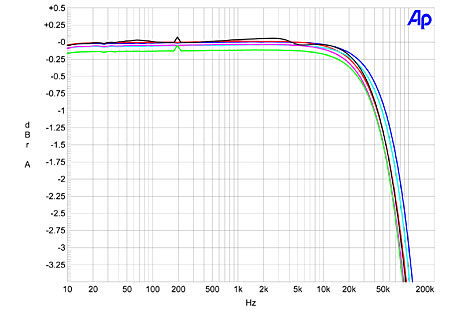
Fig.1 Simaudio Moon Evolution W-7, frequency response at 2.83V into: simulated loudspeaker load (gray), 8 ohms (left channel blue, right red), 4 ohms (left cyan, right magenta), 2 ohms (green). (1dB/vertical div.)
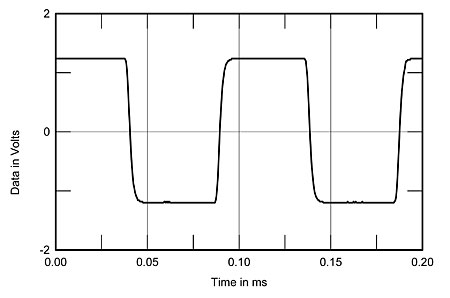
Fig.2 Simaudio Moon Evolution W-7, small-signal 10kHz squarewave into 8 ohms.
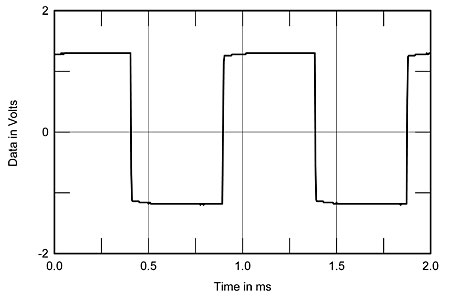
Fig.3 Simaudio Moon Evolution W-7, small-signal 1kHz squarewave into 8 ohms.
Channel separation was superb, at better than 117dB in both directions below 1kHz, and still 107dB (R–L) and 98dB (L–R) at 20kHz. Despite its higher-than-usual voltage gain, the Simaudio amplifier was also very quiet, its unweighted, wideband signal/noise ratio (ref.1W into 8 ohms) measuring 84.4dB. Restricting the measurement bandwidth to the audioband improved this figure to a superb 92dB, while switching in an A-weighting filter improved the ratio even further, to 94.4dB. This is an amplifier capable of getting the best from high-resolution audio files, especially given its high power capability.
Fig.4 plots the THD+noise percentage present in the W-7's output against output power into (from bottom to top at 1W) 8 and 4 ohms with both channels driven, and 2 ohms with one channel driven. With clipping defined as the point when the THD reaches 1%, the W-7 significantly exceeded its 150Wpc, 21.75dBW rating into 8 ohms, not clipping until 200Wpc (23dBW). The amplifier delivered 310Wpc into 4 ohms (21.9dBW) and 505W into 2 ohms (21.05dBW). The last figure is 0.7dB below the rated power into this load (footnote 1), but note that I don't hold my wall AC voltage constant for these tests.
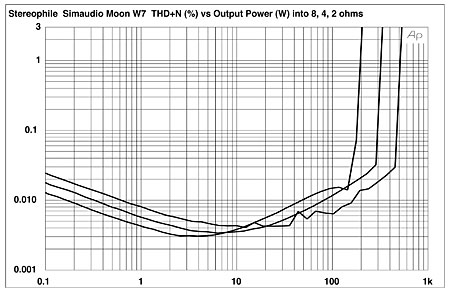
Fig.4 Simaudio Moon Evolution W-7, distortion (%) vs 1kHz continuous output power into (from bottom to top at 1W): 8, 4, 2 ohms.
The shapes of the traces in fig.4 indicate that the actual distortion harmonics begin to rise out of the noise floor around 10W. I therefore plotted how the THD+N percentage changes with frequency at a level higher than this, 16V RMS, which is equivalent to 32W into 8 ohms. The results are shown in fig.5: the THD is very low in level, and remarkably even for the left channel into 8 and 4 ohms (blue and cyan traces), but rises above 1kHz for the right channel (red and magenta) and for the left channel into 2 ohms (green). The level is still low at the top of the audioband, but these results do suggest that, unless an error crept into my measurement setup, the right channel's open-loop bandwidth is a little lower than the left's.
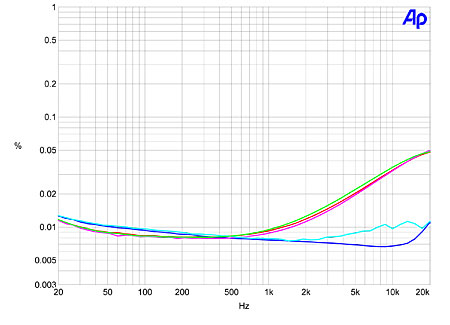
Fig.5 Simaudio Moon Evolution W-7, THD+N (%) vs frequency at 16V into: 8 ohms (left channel blue, right red), 4 ohms (left cyan, right magenta), 2 ohms (green).
What matters more than the absolute level of an amplifier's distortion is the spectral content of that distortion, and in this respect the Moon W-7 did well. The waveform of the left channel's spuriae at a moderate level into 4 ohms (fig.6) indicates that the primary harmonics present are the subjectively benign second and third, although, as clipping is approached, higher harmonics begin to approach the –100dB line (0.001%), as can be seen in fig.7. Again, the right channel is slightly worse than the left. This is also evident in the plot of the W-7's performance on the demanding high-frequency intermodulation test (fig.8), where the right-channel spuriae (red traces) are higher than the left (blue). Even so, none of the intermodulation products exceeds –82dB (0.008%) in level, and the second-order difference product at 1kHz, even in the right channel, lies almost 90dB below the peak of the waveform (0.003%).
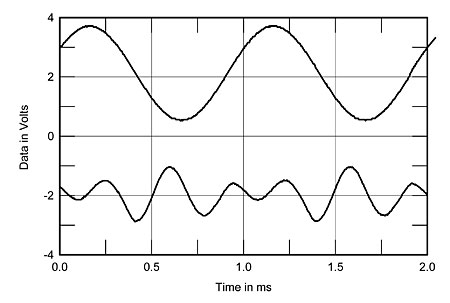
Fig.6 Simaudio Moon Evolution W-7, 1kHz waveform at 40W into 8 ohms (top), 0.00875% THD+N; distortion and noise waveform with fundamental notched out (bottom, not to scale).
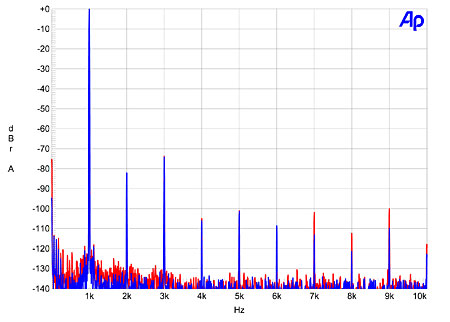
Fig.7 Simaudio Moon Evolution W-7, spectrum of 1kHz sinewave, DC–1kHz, at 200W into 4 ohms (left channel blue, right red; linear frequency scale).
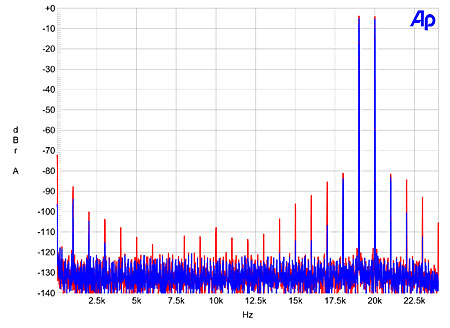
Fig.8 Simaudio Moon Evolution W-7, HF intermodulation spectrum, DC–24kHz, 19+20kHz at 100W peak into 8 ohms (linear frequency scale).
Other than the slight discrepancy in high-frequency linearity between the channels, Simaudio's Moon Evolution W-7 is a superb example of how high a level of performance can be achieved with a fairly conventional class-AB design.—John Atkinson
Footnote 1: However, while the W-7 is claimed to deliver 600Wpc into 2 ohms in the specifications listed on Simaudio's website, a figure of 500Wpc into 2 ohms is mentioned in the original press release. If the latter is correct, then the amplifier does meet its specified power into this load.
- Log in or register to post comments




































